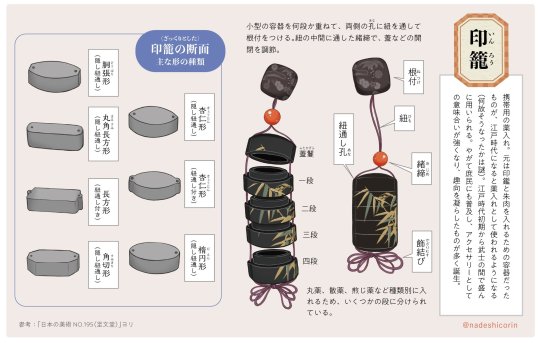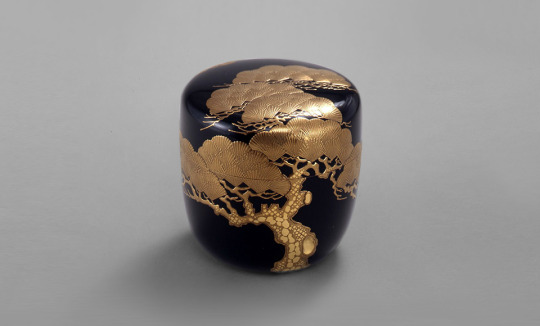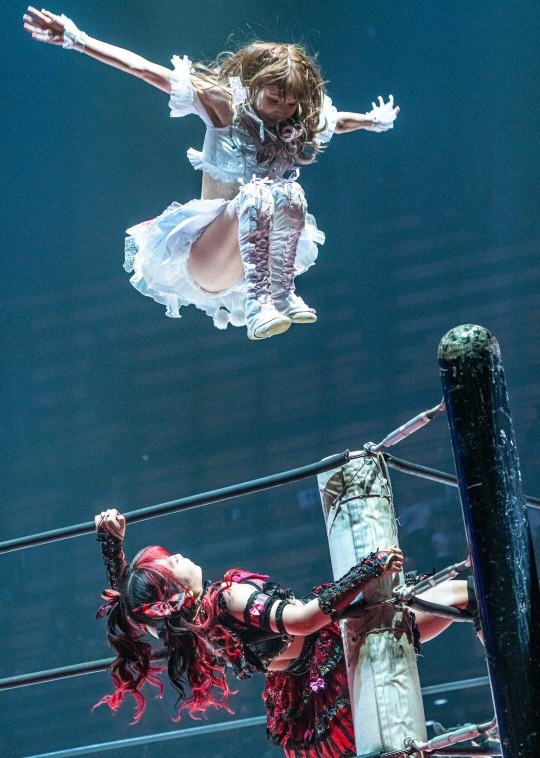#makie
Explore tagged Tumblr posts
Photo

印籠 (inrô) pill box/nested boxes, handy chart by fantastic Edo-lover Nadeshico Rin.
Inrô were first used during Sengoku period by men to carry their personal seals (印鑑 inkan) and thick red ink (朱肉 shuniku). It was then used to carry medecines (薬 kusuri), such as pills (丸薬 ganyaku), powders (散薬 sanyaku), or decoctions (煎じ薬 senjigusuri). Slowy people also added any small trinkets which could fit in.
First carried by samurai class, it then spread to chônin commoners in the Edo period. Many shapes existed, and inrô boxes could be made from many materials depending of their owners’ fortune, from paper to precious ivory. Often beautifully decorated, their designs could include raden (mother of pearl inlays), or makie (gold powder).
On the right, you can see the different part of an inrô:
根付 (netsuke) carved toggle (sometimes very intricated miniature sculptures), slipped into the obi belt
紐 (himo) cord, holding everything together
緒締 (ojime) string-fastener bead, could be made from precious coral or as decorated as netsuke
飾結び (kazari musubi) ornamental knot, at the bottom
紐通し孔 (himodôshiana) lacing hole, to thread the cord into the boxes
蓋鬘 (futakazura) top piece, lid of the box
段 (-dan) row of boxes, ex. 一段 (ichidan) first row
Main types of inrô shapes existed, with of without visible lacing holes (紐通し付き himodôshi tsuki = visible / 隱し紐通し kakushi himodôshi = hidden). Rin details following styles on the left:
杏仁形 (kyônin gata) apricot seed shaped
楕円形 (daen gata) ellipse�� shaped
胴張形 (dôbari gata) hull shaped
丸角長方形 (marusumi chôhôkei) rounded rectangle shaped
長方形 (chôhôkei) rectangle shaped
角切形 (sumikiri gata) cut-corners shaped
#japan#fashion#fashion history#edo period#references#ressources#nadeshico rin#inro#inrou#pill box#medecine box#kusuri#samurai#raden#mother of pearl inlay#makie#gold powder#netsuke#toggle#chart
440 notes
·
View notes
Text
The wheel has decided on our next victim: Makie Osakabe!
So without further ado:

Wanted to draw her in a dess, dunno why.
And the natural lighting has been shit in the last few days (rainy/cloudy), so this is kinda the best I could do :(
Progress pics under the cut

Forgot to take pictures of the sketching progress, but here we are at the beginning of lining.




3 notes
·
View notes
Text

3 notes
·
View notes
Text

This is a c. 1957 Yotsubishi ink shut-off eyedropper fountain pen decorated using a Shibayama style Raden mother-of-pearl shell inlay technique on red urushi lacquer. The pen was featured in the winter 2006 Pennant article “Collecting Japanese Pens” by Stan Klemanowicz. The pen was made by Ishi-Shoten Yotsubishi (literally yotu = four, bisi = diamond), a company from Osaka that made highly collectible decorated pens, but according to the article, sourced nibs and hardware from other pen companies. The four diamond logo can be seen on the top of the clip and on the cap band. The nib on this example is made by Platinum and is stamped PLATINUM over 14K. GOLD over 30 YEAR over 3 over PEN. The nib is likely a replacement.
Read the story about this interesting pen here:
https://www.penhero.com/PenGallery/Yotsubishi/YotsubishiShibayama1957.htm
2 notes
·
View notes
Text
THE SHEER DEFINITION OF HAPINESS

6 notes
·
View notes
Text


Uncle Gojo!!
#I’m doing great guys!! /lying#He should get to watch his students thrive!! He should get to hold their ugly babies!! He should be present and a bother!! 🥹🥹🥹#my art#bluebeesart#jujutsu kaisen#jjk#satoru gojo#yuta okkotsu#maki zenin
10K notes
·
View notes
Text

type of photos their grandchildren found hehe
9K notes
·
View notes
Text


trick or treat!
#my art#jjk#jujutsu kaisen#jjk fanart#jujutsu kaisen fanart#yuji itadori#fushiguro megumi#nobara kugisaki#maki zenin#yuta okkotsu#inumaki toge#jjk spoilers#jjk manga spoilers#u could argue that the spoilers r hidden by the costumes but idw take my chances#i havent posted art in a billion years i feel like a fraud and i am going to get a bad grade in tumblr dot com#so i am posting these early idc anymore#i still have probably one more halloween draws i plan on posting but im cracking i want these out of my drafts Now#these KILLED ME#i miss drawing fast i miss it so badddddd#dont get me wrong the costume design ws so fun i loved it but god did it take ages#but on the bright side. yuuji in a toga.#on another bright side. little devil nobara n cowgirl maki#on yet anotHER bright side. eldritch horror pandachu#these costumes eat if i do say so myself ghjsdfkgjf undead inuokko makes me so happy also they r so cute#not to mention megumi in his gay little hat god i made itfs so obnoxiously flirty in this#remember when i said the timeskip art ws the least heterosexual group photo i've ever drawn i take it back#theyre disgusting . save nobara episode 356325746732#anyway happy 10 days early halloween <3#i will try to not take a whole week to finish the last piece(s)
14K notes
·
View notes
Text

I wish they interacted in DR:S 😭
#maki harukawa#harukawa maki#mukuro ibukasa#ikusaba mukuro#danganronpa#trigger happy havoc#dr1#dr1 trigger happy havoc#ndrv3#drv3#new danganronpa v3#yuli art#dr1 spoilers#ish#Mukuro and maki looking at each other going:#‘You’re way more dangerous than you look but so long as you don’t blow my cover I won’t blow yours’#and have the most awkward conversations ever#can you imagine….
6K notes
·
View notes
Text










6K notes
·
View notes
Text
後藤真希 / Maki Goto

3K notes
·
View notes
Text

redraw of my first ever danganronpa fanart

#danganronpa#danganronpa trigger happy havoc#super danganronpa 2#new danganronpa killing harmony#drv3#sdr2#dr thh#maki harukawa#kyoko kirigiri#chiaki nanami#my art
5K notes
·
View notes


